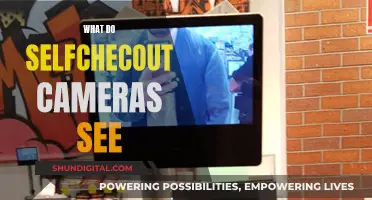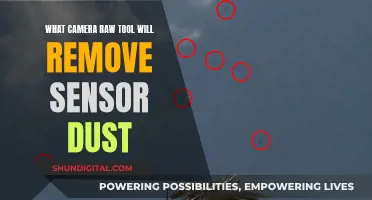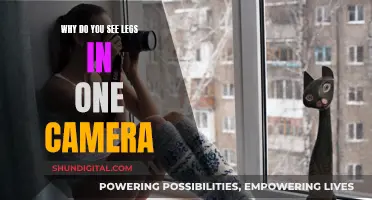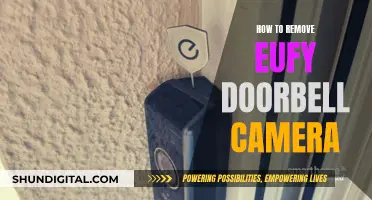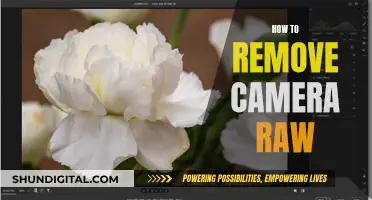
A pinhole camera is a simple imaging device that captures images without the use of a lens. It consists of a light-proof box with a tiny aperture, known as the pinhole, on one side. When light from a scene passes through the pinhole, it creates an inverted image on the opposite side of the box, known as the camera obscura effect. This effect has been observed and studied by various scholars throughout history, including Chinese philosopher Mozi in the 5th century BCE, and Arab physicist Ibn al-Haytham (or Alhazen) in the 11th century. The image formed by a pinhole camera is real, inverted, and smaller than the actual object, and it can be projected onto a translucent screen for real-time viewing or captured on photographic film or paper.
| Characteristics | Values |
|---|---|
| Type of camera | Pinhole camera, camera obscura, "dark chamber" |
| Components | Light-proof box, film, pinhole |
| Image formation | Light enters through the pinhole, creating an inverted image on the opposite side |
| Image projection | Images are projected onto a translucent screen or photographic film/paper |
| Image characteristics | Smaller than the actual object, inverted on the x-axis and y-axis, can be used for analysis of rectilinear propagation of light |
| Image quality | Smaller pinhole size results in a sharper image, but dimmer projection |
| Exposure time | Longer exposure time is required due to limited light entering through the pinhole |
| Uses | Artistic photography, solargraphy, surveillance, observation of solar eclipses |
| History | One of the earliest predecessors of modern-day cameras, first described by Mozi in 500 BCE, popular in the 19th century |
What You'll Learn

The pinhole camera model
Despite its limitations, the pinhole camera model is useful in fields like computer vision and computer graphics, as it provides a reasonable description of how a camera depicts a 3D scene.
Impeachment Circus: Who's Watching the Camera Show?
You may want to see also

How a pinhole camera works
A pinhole camera is a simple camera without a lens. It is a light-proof box with a tiny aperture, known as the pinhole, on one side. The pinhole is an extremely small hole, often made with a pin in a piece of thick aluminium foil.
The pinhole camera works on the principle of the straight path of light. Each point of an object emits light, and the beam of light from that point passes through the pinhole, creating a point of light on the back wall of the camera. All the points of the object do this simultaneously, so an entire image, in focus, is created on the back wall of the camera. The image is inverted because only the inclined rays can pass through the hole. The rays from the top of the object gradually move downward, and the rays from below move upward, forming an inverted image on the wall of the camera.
The size of the image depends on the distance between the object and the pinhole. The smaller the pinhole, the smaller and sharper the image, but the dimmer the projected image will be. The image can be projected onto a translucent screen for real-time viewing, or to trace the image on paper. However, it is more often used without a screen for pinhole photography, with photographic film or paper placed on the surface opposite the pinhole.
Locking Your Camera on Omegle TV: A Step-by-Step Guide
You may want to see also

The history of the pinhole camera
In the 10th century CE, the Arabian physicist and mathematician Alhazen, or Ibn al-Haytham, described the usefulness of a pinhole for viewing a solar eclipse without damaging the eyes. In the 16th century, Leonardo da Vinci gave a clear description of the camera obscura in his notebooks. He wrote:
> "When the images of illuminated objects pass through a small round hole into a very dark room…you will see on paper all those objects in their natural shapes and colours…Who would believe that so small a space could contain the image of all the universe?"
During the Renaissance, the camera obscura was used as a drawing aid for artists and amateur painters. In the 19th century, several large-scale camera obscuras were built as places of education and entertainment. The first published picture of a pinhole camera obscura is a drawing by Gemma Frisus, an astronomer who used the pinhole to study the solar eclipse of 1544.
The first photographs were developed in the early 19th century, and pinhole photographs soon followed. Sir David Brewster, a Scottish scientist, was one of the first to make pinhole photographs in the 1850s. The oldest extant pinhole photographs were probably made by the English archaeologist Flinders Petrie during his excavations in Egypt in the 1880s. Pinhole photography became popular in the 1890s, with commercial pinhole cameras being sold in Europe, the US, and Japan.
Paranoia or Reality: FBI Surveillance via My Camera?
You may want to see also

How to make a pinhole camera
A pinhole camera is a simple device that can be made with a few materials. Here is a step-by-step guide on how to make one:
Firstly, gather your materials. You will need a cardboard box (an empty shoe box can work), a sharp pencil, an X-Acto knife, scissors, and some tape. Optionally, you can also use a piece of wax paper or aluminium foil.
Once you have your materials, follow these steps:
- Use the sharp pencil to make a small hole in one of the shorter ends of the box. This will be your pinhole.
- With the help of an adult, use the X-Acto knife to cut a square, measuring about 2 inches by 2 inches, on the opposite end of the box, directly across from the pinhole. This will be your viewing aperture.
- If you are using wax paper, cut a square that is slightly larger than the viewing aperture, about 3 inches by 3 inches. Tape the wax paper over the square hole you cut, ensuring that the paper is secure and there are no gaps for light to enter.
- Take your pinhole camera to a dimly lit room and turn on a lamp. Stand about 5 feet away from the light source.
- Cover your head and the camera with a blanket, ensuring that the pinhole end is facing the lamp and the wax paper end is facing you.
- Hold the camera at arm's length and aim it at the lamp. Keep it steady, and you should see an upside-down image of the lamp projected onto the wax paper.
You can experiment with different materials and distances to improve the image quality. For example, you can try using aluminium foil instead of wax paper, or adjust the distance between the camera and the light source.
The pinhole camera works by allowing light to enter through the pinhole, creating an inverted image on the opposite side. This phenomenon is known as the camera obscura effect. The smaller the pinhole, the sharper the image will be, but the dimmer the projection will become.
Pinhole cameras are a great way to learn about the basics of photography and the behaviour of light. They can also be used for artistic purposes and to observe the movement of the sun, known as solargraphy.
Spot Hidden Pinhole Cameras: Quick Tips and Tricks
You may want to see also

Pinhole camera uses
Pinhole cameras are used for a variety of purposes, both practical and artistic.
One of the most common uses of pinhole photography is to capture the movement of the sun over a long period of time, a practice known as solarigraphy or solargraphy. This technique was first used by Arab scholar Ibn al-Haytham (Alhazen) in the 11th century, who used a pinhole camera to demonstrate how light can be used to project an image onto a flat surface. Pinhole cameras are also used to safely observe solar eclipses, as well as for surveillance due to their small size and inconspicuous appearance.
Pinhole cameras are also used for educational purposes, allowing students to learn about and experiment with the basics of photography. They are simple to make and use, and can be constructed from everyday objects such as a shoebox or a coffee can. The process of making and using a pinhole camera can encourage creativity and experimentation with photography.
In addition, pinhole cameras played a significant role in the development of modern photography. They were used by early photographers such as Sir William Crookes and William de Wiveleslie Abney, and were noted for the soft outlines they produced in images, in contrast to the sharp images generated by lenses. Pinhole cameras were also used by artists in the 1960s, who experimented with this simple apparatus to create unique atmospheric images.
Remotely Viewing Kamtron Cameras: A Step-by-Step Guide
You may want to see also
Frequently asked questions
A pinhole camera is a light-proof box with a small hole (the pinhole) on one side. Light from outside the box passes through the pinhole and projects an inverted image on the opposite side of the box. This is known as the camera obscura effect.
The camera obscura effect is a natural optical phenomenon where light passes through a small opening, creating an inverted image on the opposite side. This effect has been observed since ancient times, with early descriptions found in Chinese and Greek writings from the 5th century BCE.
The size of the pinhole affects the sharpness and brightness of the image. Smaller pinholes create sharper and dimmer images, while larger pinholes result in blurry and brighter images. The optimal size for the pinhole is approximately 1/100 or less of the distance between it and the projected image.
Advantages of a pinhole camera include its simplicity, infinite depth of field, and ability to capture unique images with soft outlines. However, a major disadvantage is the extremely long exposure time required due to the small amount of light entering through the pinhole. This makes it challenging to capture moving subjects and requires the camera to be held very still.


